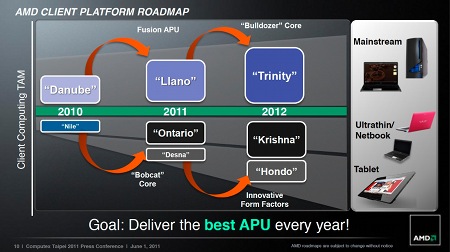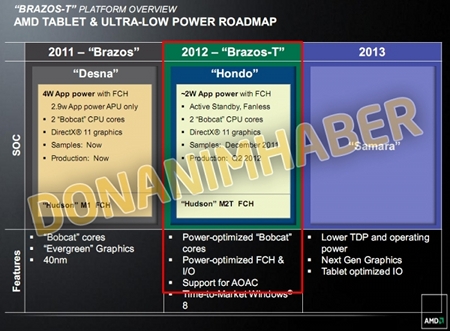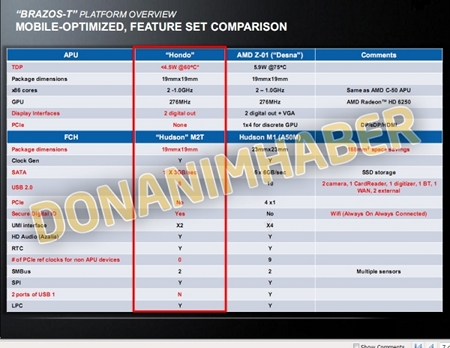AMD tablet CPU to deliver active sleep, always-on Wi-Fi, report says
Jul 5, 2011 — by LinuxDevices Staff — from the LinuxDevices Archive — viewsAMD is planning a tablet-specific processor featuring fanless operation, “active standby,” and the ability to provide continuous Wi-Fi connectivity. Using between two and 4.5 Watts, “Hondo” will be accompanied by a downsized “Hudson M2T” I/O controller that drops PCI Express but adds SDIO, according to the Donanim Haber website.
It appears there is a mole in AMD's Turkish operation, since information — subsequently proven accurate — about the company's upcoming processors has more than once been leaked on the Donanim Haber website. (In March, for instance, the site provided early info on AMD's A-Series "Llano" processors.)

AMD mentioned the Hondo codename last month
(Click to enlarge)
Now, Donanim Haber again offers what appear to be slides leaked from an AMD presentation. We're inclined to credit the details as genuine, especially since AMD already mentioned the "Hondo" name in a different slide (above) when it announced its Z-Series ("Desna") processor last month.
The Z-01 processor revealed on June 1 is a tablet-focused follow-on to the chipmaker's earlier "Bobcat"-based processors, which have included the E-Series and C-Series (for mobile devices and low-power desktops) as well as the G-Series. It includes two Bobcat cores, a 1.0GHz clock speed, Radeon HD6250 graphics with 80 GPU cores, and a 5.9-Watt TDP, according to AMD.
We commented at the time that, apart from a slightly more favorable TDP, the Z-01 specifications are identical to those for AMD's earlier C-50. With "Hondo," however, AMD appears to be readying a much more significant pass at the tablet market.

AMD tablet roadmap
Source: Donanim Haber
(Click to enlarge)
According to the slides reproduced by Donanim Haber, Hondo will be just as big as the Z-01 at 19 x 19mm, but it will use a maximum of 4.5 Watts and will be capable of running fanlessly. Again with dual Bobcat cores and Radeon HD6250 graphics, the chip will have two digital video outputs, but will apparently drop support for analog VGA.

Hondo feature set comparison
Source: Donanim Haber
(Click to enlarge)
The Z-01 has a PCI Express x4 interface so that products based on it can support add-on discrete GPU (graphics processing units) or other peripherals. But in the quest for simplification and, hence, low power consumption, Hondo omits PCI Express x4, one of the Donanim Haber slides indicates.
The slides add that the overall "Brazos-T" platform of which Hondo is a part also includes a downsized (19 x 19mm) I/O controller code-named Hudson M2T. Again simplified in order to save energy, this will pare down SATA to a single 3Gbps port and eliminate USB 1.1, Donamin Haber says.

Hudson M2T I/O controller
Source: Donanim Haber
(Click to enlarge)
But even as it takes away features that are not needed on tablets, Hudson M2T will add a new one that's very cool. The I/O controller provides SDIO support for an "always on, always connected" Wi-Fi adapter that will allow Hondo-based tablets to feature "active standby," the slides indicate.
Availability
According to the slides reproduced by Donamin Haber, the Hondo processors will begin sampling in December and enter production during the second quarter of 2012. This will enable devices based on the chips to become available before the release of Windows 8, AMD is apparently suggesting.
Jonathan Angel can be reached at [email protected] and followed at www.twitter.com/gadgetsense.
This article was originally published on LinuxDevices.com and has been donated to the open source community by QuinStreet Inc. Please visit LinuxToday.com for up-to-date news and articles about Linux and open source.